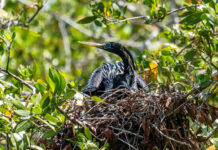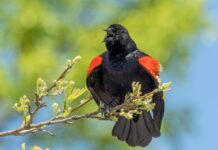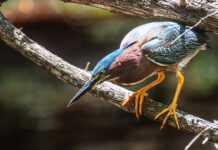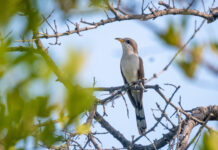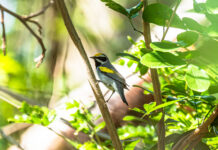
There was no path up the mountain. They had to hire some local field workers to create one with machetes, which was fine with the field workers. It was a nice change from harvesting bananas.
Once there was a path to the top, they could see it – the treetop canopy below, which was what they wanted.
Jeffrey Podos, a biology professor at the University of Massachusetts, had his suspicions about the white bellbird before he and his research partner, Mario Cohn-Haf of the Instituto Nacional de Pesquisas da Amazônia, climbed that path up the mountain in Amazonian Brazil. They went to study and record two species of birds, the screaming piha and the white bellbird. Both were canopy dwellers, birds that lived in treetops that were often 60, 80, 100 feet above the ground, which made them difficult to study. Unless you found the right mountaintop.
Previously it was thought the screaming piha was the loudest known bird species in the world. Recordings Podos, Cohn-Haf and their team made showed it was actually the white bellbird, which could produce a call three times as loud as the piha’s.
They published their findings in a 2019 paper entitled, “Extremely loud mating songs at close range in white bellbirds,” in the journal “Current Biology.”
I’ve always thought the screaming pihas would be a great name for a punk band and, who knows, there is still a chance that some day some small cadre of maladjusted young musicians could take it up. And I’ve actually heard screaming pihas a couple times in real life, both in Peru and Guyana, and they lived up to their name, their call being a very loud and high pea pea-ha. If you want to hear them from the comfort of your own couch, you can Google it. You can also watch Werner Herzog’s epic “Fitzcarraldo,” as they are calling all over the soundscape of that movie. (They are probably also in the background of “Burden of Dreams,” the documentary about Herzog’s torturous and insane struggle to complete “Fitzcarraldo,” but I mostly just remember them fighting to portage a 320-ton steamship over a mud-slicked hill.)
I’ve seen and heard the bearded bellbird, which is closely related to the white bellbird, quite a few times in Trinidad. They are loud, though I’m not sure exactly how loud, and their call doesn’t sound like a bell so much as two clappers banging together.
I’ve never seen or heard a white bellbird in real life, though I have been thinking about them quite a lot lately.
It started when someone asked me a question with local import a couple months ago: “Is it true the rooster is the loudest bird in the world?”
I didn’t know. So I started doing a little research. And it turns out that both the rooster — the male gallus gallus domesticus — and the white bellbird have been recorded at levels of 125 decibels, but the bellbird was generally considered the loudest bird in the world. I read up on different recording methods, how sound travels through different types of air, how it diminishes over distance, what the different units of measurements were and other bits of acoustical science, and realized there was a reason I quit engineering school. But I also got pretty curious. How do you accurately measure the call of a bird 100 feet up in the canopy?
So I reached out to Jeffrey Podos and he kindly agreed to talk to me on Zoom, which is how I learned about the path up the mountain.
In the canopy below, they could see and hear up to eight adults singing at a time. They could triangulate their sound, figure out which bird was calling when. Occasionally they could get as close as 25 meters to one of them.
The white bellbird has two calls, both of which are very simple, the first being a brief sort of bell-like bong, with amplitude being prized over nuance, musicality or duration. The second is two brief bongs with very similar characteristics to the single bong call. It is basically audible brute force.
What is the point of all this loudness? Podos thinks it comes down to the fact that they are fruit eaters.
“Most birds are just desperately hungry all the time, and they devote most of their waking hours to getting food,” Podos said. For frugivores, though, life is much different than it is for songbirds who spend their days searching for insects and seeds. “If you can find a fruiting tree, then you can just take a couple of trips per day. So you have all this time to spend.”
Male white bellbirds are a very crisp, conspicuous white, with a single wattle that looks a bit like a small snake hanging out of their nostril, something they fling around when they make their calls. Females are drab and inconspicuous, able to disappear in the shadows of the forest.
“Basically females can feed babies very well on their own. They don’t need the males to be good dads,” he said. “Males can actually harm babies because they’re so conspicuous. And if they are there helping with the nest, then predators are more likely to find the babies and eat them.”
The males are left with not much else to do but compete with each other for female attention – the avian equivalent of dance-hall lotharios – and somewhere in the evolutionary process females showed a preference for the louder males.
Males being males, it is possible their competitiveness outpaced the thing that initially attracted females – as evidenced by the fact that most times, when a female white bellbird sidles up to a male, and he decides to give her his best bong, or bong bong, the female will duck her head and turn away, as if to avoid the full brunt of the call.
Podos gave me some good, clear explanations for why the white bellbird holds the title of loudest bird, covering such subjects as distance, calibrated electronics, the spherical spreading equation, frequencies, microphone placement, background noise, how sound energy moves through the air, how it dissipates and degrades, and several other aspects of acoustic measurements that totally lost me. So I’m going to trust his doctorate, his research and his basic understanding of how all this works, because science is real, no matter how much it confounds you.
Also, he said that while the white bellbird is the loudest bird that has been recorded, it may not be the loudest bird in the world.
“I think there are louder birds out there,” he said. “There are just not that many people running around with these calibrated recorders.
“They’re so mysterious, these animals,” he said.












